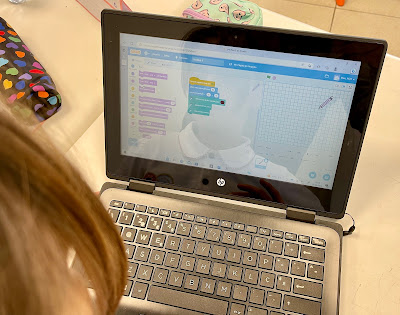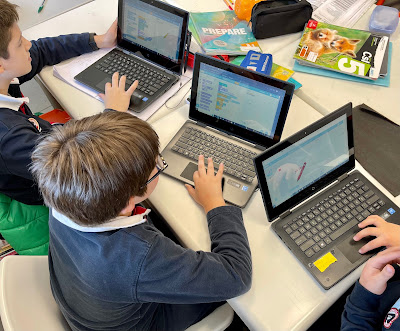- https://dataconomy.com/2023/10/16/best-ai-tools-for-teachers/
- https://www.magicschool.ai/
- https://almanack.ai/
- https://educationcopilot.com/
- https://www.slidesai.io/pt
- https://www.gradescope.com/
- https://support.microsoft.com/en-us/office/rehearse-your-slide-show-with-speaker-coach-cd7fc941-5c3b-498c-a225-83ef3f64f07b
- https://quillbot.com/
- https://www.querium.com/
sábado, 23 de dezembro de 2023
Magic School AI
domingo, 3 de dezembro de 2023
Vida de Professor
quarta-feira, 25 de outubro de 2023
Relatório de Monitorização Global da Educação UNESCO 2023
segunda-feira, 23 de outubro de 2023
MATH LEARNING CENTER
domingo, 1 de outubro de 2023
A luta titânica entre Digital e Analógico...
domingo, 17 de setembro de 2023
VIII Encontro sobre Inovação Pedagógica SUPERTABi 2023
segunda-feira, 31 de julho de 2023
VIII Encontro Internacional sobre Inovação Pedagógica SUPERTABi 2023
terça-feira, 16 de maio de 2023
segunda-feira, 15 de maio de 2023
Open Educational Resources / Recursos Educacionais Abertos
Large Databases for Open Educational Resources
These databases are a good starting point to find a wide variety of open educational resources.
- Open Textbook LibraryThis database, overseen by the Open Textbook Network, includes books authored by faculty at more universities across the country, and many include peer reviews. You can browse by subject or do a simple search.
- OASISA new database to search hundreds of sources of OERs hosted by SUNY Geneseo.
- Mason OER MetafinderSimilar to OASIS, it allows you to search other OER databases at once. Run by George Mason University
- OER CommonsThis database of OERs lets you search by education level, learning material type and accessibility. Supported by the not-for-profit group Institute for the Study of Knowledge Management in Education.
- BCCampusBrowse this collection of 159 textbooks by topics or use a simple search. About half include peer reviews. BCCampus, supported by the government of British Columbia, curates the OERs created by British Columbia academic institutions.
- Teaching CommonsBrowse for OERs in this aggregated database by the creator's institution, material type and subject.
- HathiTrust Digital LibraryUse this database to search a variety of material formats that are in the public domain or were made open from universities across the country. Make sure to use the Full Text search to ensure access to the material.
- MerlotRun by the California State University System, MERLOT curates OERs that have been licensed for reuse and materials that are online for free. Search includes audience, language, material type, Creative Commons licenses and accessibility.
- Open Educational Resource 2017 Textbook ListAlthough not a database, this in depth list breaks down OERs by discipline.
Other Sources for Open Educational Resources
Although not as well-known as the above databases, these sites can also be good places to find open educational resources, including textbooks and other material.
- Saylor Academy Open TextbooksThese 100-plus OER textbooks are maintained and vetted by Saylor Academy. No search built in but easy to browse.
- Directory of Open Access BooksAlthough not focused on textbooks, this database curates scholarly books that are free and open to reuse.
- OAPENSimilar to the Directory of Open Access Books, this database curates free and open scholarly books in Europe.
- National Academies Press Open BooksSearch more than 8,000 books released by the NAP, which publishes the reports of the National Academies of Sciences, Engineering and Medicine.
- OpenStaxAlthough small, this collection of 34 textbooks covers some of the basic introductory classes in the maths, sciences and social sciences. The books have all been peer reviewed.
- OpenMichiganThis site collects OERs created by University of Michigan authors. Browse by subject.
- OpenSUNYBrowse by subject or author of OERs created by authors with the SUNY system.
- MIT OpenCourseWareSearch through OERs created by MIT. Materials include textbooks, audio/visual lectures, lecture notes, assessments and courseware.
- University of Nevada, Reno's open access databasesThe Knowledge Center curates this list of databases that include open material.
- OER for Technical Communication ClassesA curated list from the University of Kentucky
Open Audio, Video, and Images
Open educational resources don't have to be just textbooks; any material you use in the classroom can be open. These sites focus on other materials - images, videos, and audio - that are free to use and, in some cases, licensed for adaption.
Multimedia
- Digital Public Library of AmericaThe Digital Public Library of America aggregates more than 14 million items from libraries, archives and museums. Items include text, videos, images and audio.
- New York Public Library Digital CollectionsThe New York Public Library has made almost 700,000 items - mostly images, although text, maps, audio and movie files are included - in their digital collections free to the public. Check individual items for any other copyright restrictions.
- USA.govDo a simple search or browse through videos and images from the federal government.
- The Public Domain ProjectHosted by the stock footage company Pond5, this website curates almost 100,000 image, video, audio and 3D model files in the public domain.
- SmarthistoryFocused on art and art history, this website includes images and videos based on geography, time periods and styles and themes.
- Library of CongressAbout a dozen collections that include free to use and reuse material.
Images
- Getty ImagesGetty Images has more than 100,000 images that are considered open. This search page is set up to include only those images.
- Wellcome ImagesThese images from the Wellcome Trust have a focus on current and historical medical topics.
- Google ImagesThis advanced search page for Google Images allows users to search for images that include a Creative Commons license. Use the last filter on the page, Usage Rights, to set your terms.
- FlickrLike Google images, Flickr also allows you to search for images that come with a Creative Commons license. This page is set up for that already, but you can also filter any search by click on "any license" in the upper left corner of the page to choose what license you want.
- Visual HuntMillions of images that have been licensed with a Creative Commons license.
- SmithsonianIncludes 2.8 million images from the Smithsonian's collection that have been released in the public domain.
- PexelsStock photos that have been placed in the public domain.
- PixabayAnother site of stock photos, vectors and illustrations placed in the public domain.
Audio
- Internet Archive - MusicThousands of audio files curated in the Internet Archive. Includes all types of audio files. Check to see if specific ones are licensed to be adapted.
- Free Music ArchivesMusic that's been cleared of copyright issues. Browse by genre or most popular.
- University of Oxford PodcastsOpen podcasts made for University of Oxford classes. Browse through by topic or do a simple search.
- BandCampThese music files uploaded to BandCamp include a Creative Commons license.
- FreesoundThese audio files focus more on snippets, sounds, bleeps, etc. Includes searching by a "sounds like" feature and a help forum to make specific requests. Files should include a Creative Commons license.
Videos
- The Open Video ProjectThese free videos are curated by the University of North Carolina at Chapel Hill but have not been cleared of copyright issues. Many of them come from the federal government.
- Internet Archive - MoviesThis collection features almost 3 million videos archived by the Internet Archive. Check individual collections and movies for copyright status.
- YouTubeYou can specifically search for videos uploaded to YouTube with a Creative Commons license. After you run a search, click the Filter box at the top of your results list. From there, in the Features column, select Creative Commons.
domingo, 14 de maio de 2023
terça-feira, 25 de abril de 2023
Como poderei potenciar o chat gpt na sala de aula?
Guia de utilização do ChatGPT no Ensino Superior
quarta-feira, 22 de março de 2023
Desafio de programação de robôs: navegação autónoma em "Pista de corridas"
A introdução da robótica educativa no currículo permite que os conceitos relacionados à programação e ao pensamento computacional se tornem tangíveis, ou seja, abandonem os espaços digitais dos computadores e passem a fazer parte do ambiente real das crianças. Este processo envolve aprender a planear, aprender a criar, pensar criticamente e resolver problemas programando objetos tangíveis como robôs. Este processo traduz-se numa aprendizagem mais profunda e significativa por meio de experiências táteis que permitem aos alunos explorarem as suas ideias e raciocínios.
Ao realizarem trabalho colaborativo (através do trabalho de pares ou de grupo), os alunos desenvolvem valências e competências relacionadas com valores, comportamentos, partilha e o saber estar pela utilização de robôs na execução das tarefas propostas. A utilização de robôs para a realização das atividades, através do “aprender fazendo”, permite um progresso visível nos conhecimentos adquiridos pelos alunos, onde a vertente lúdica que está associada, contribuiu também para a motivação e empenho na concretização dos projetos e tarefas apresentados.
A introdução da robótica educativa no currículo mostra-se assim uma experiência muito rica e válida para os alunos, onde o uso de artefatos tangíveis (robôs) associados à aprendizagem dos conteúdos do currículo, melhora as suas aprendizagens individuais e o desenvolvimento do seu pensamento computacional possibilitando que eles aprofundem os seus conhecimentos.
Libertar a criatividade com Scratch
O Scratch é uma plataforma de programação visual que é utilizada para auxiliar a aprendizagem dos alunos, principalmente no ensino de competências STEAM. Com o Scratch, os alunos podem criar projetos interativos e aliciantes, desenvolver as suas habilidades de resolução de problemas e pensamento lógico, além de aprender conceitos fundamentais de programação de forma divertida e intuitiva. O Scratch promove a criatividade, a colaboração e a autoexpressão dos alunos, permitindo que eles desenvolvam projetos personalizados e partilhem as suas criações com outros alunos e professores. Com estas habilidades e competências, os alunos estarão melhor preparados para enfrentar os desafios do mundo digital e se tornarem criadores de tecnologia e não apenas consumidores.
Mais vistas
-
Algumas sugestões para uma netiqueta para alunos, relembrando que esta não é, de todo, a única forma de estabelecer aprendizagens com os alu...
-
Quer publicar conteúdo online, mas lembre-se dos direitos reservados... as imagens no "Google" também não são livres de direitos. ...
-
A Google For Education junto com os autores Daiane Grassi e Eduardo Isaia Filho lançou um guia com 15 atividades para a aprendizagem a dist...
-
O Covid-19 espalha-se pelo ar, especialmente em ambientes fechados. Não é tão infeccioso quanto o sarampo, mas os cientistas já reconhecem a...
-
Estamos numa época em que a falta de professores já era uma realidade em muitas regiões do nosso país, e se analisarmos por áreas disciplina...





































































